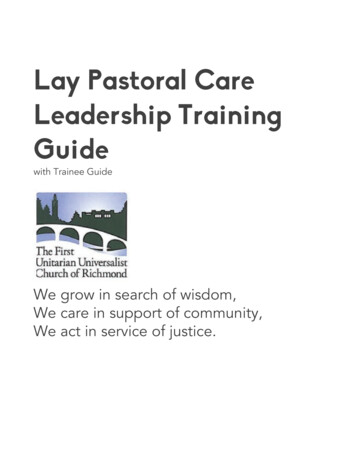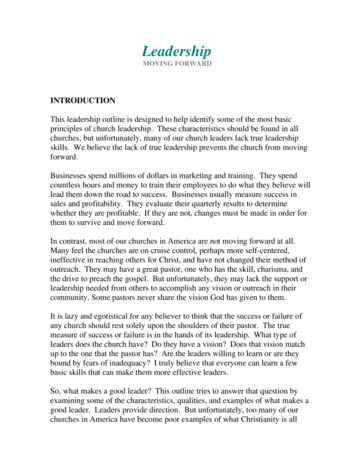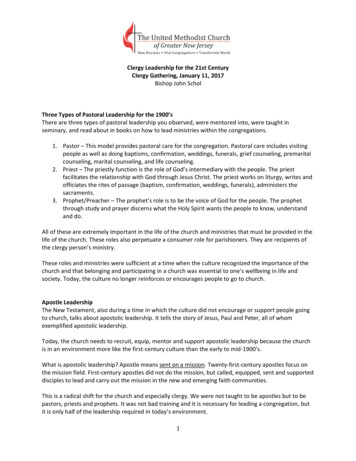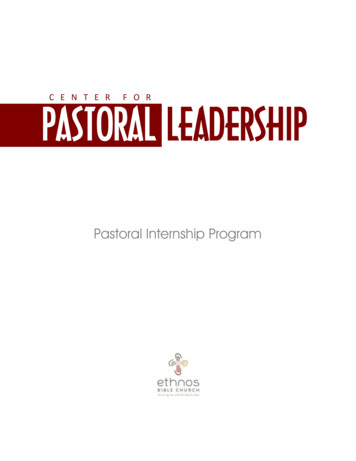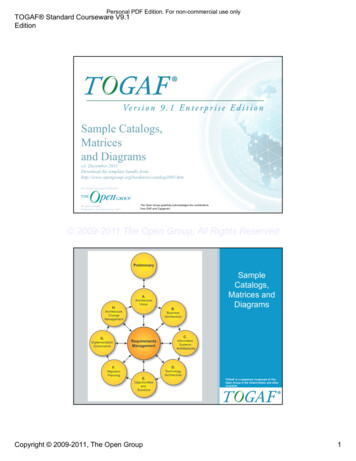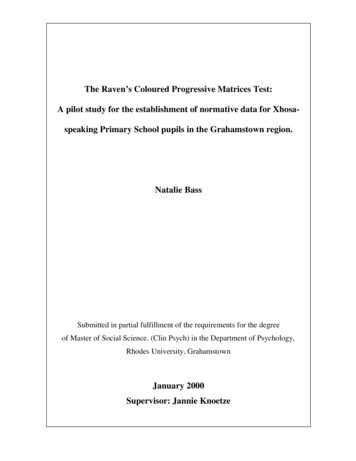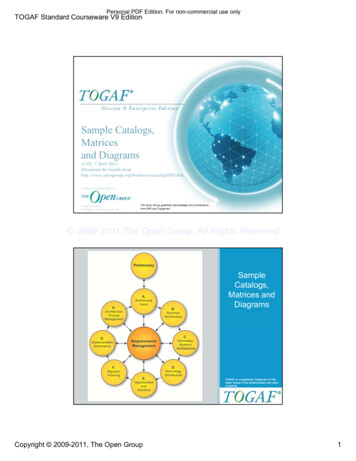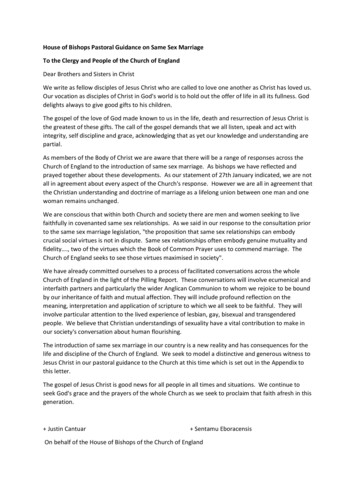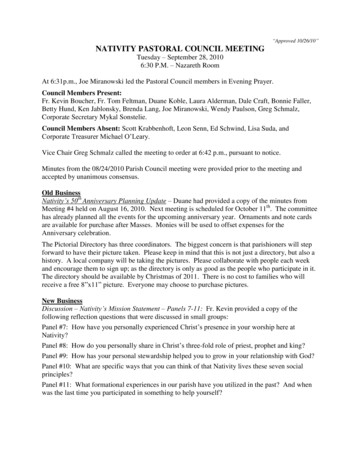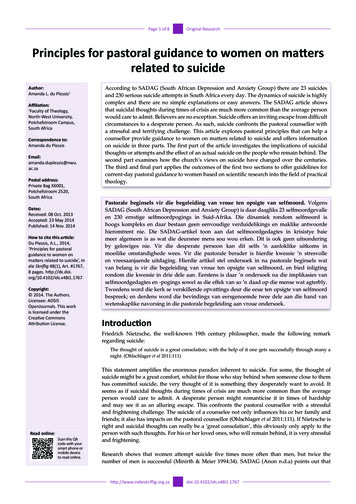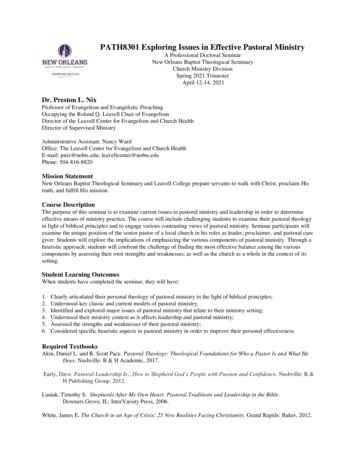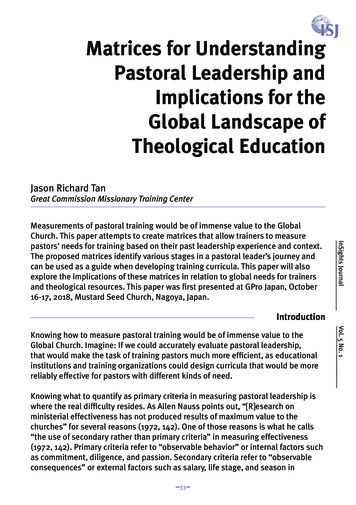
Transcription
Matrices for UnderstandingPastoral Leadership andImplications for theGlobal Landscape ofTheological EducationJason Richard TanGreat Commission Missionary Training CenterInSights JournalMeasurements of pastoral training would be of immense value to the GlobalChurch. This paper attempts to create matrices that allow trainers to measurepastors’ needs for training based on their past leadership experience and context.The proposed matrices identify various stages in a pastoral leader’s journey andcan be used as a guide when developing training curricula. This paper will alsoexplore the implications of these matrices in relation to global needs for trainersand theological resources. This paper was first presented at GPro Japan, October16-17, 2018, Mustard Seed Church, Nagoya, Japan.IntroductionKnowing what to quantify as primary criteria in measuring pastoral leadership iswhere the real difficulty resides. As Allen Nauss points out, “[R]esearch onministerial effectiveness has not produced results of maximum value to thechurches” for several reasons (1972, 142). One of those reasons is what he calls“the use of secondary rather than primary criteria” in measuring effectiveness(1972, 142). Primary criteria refer to “observable behavior” or internal factors suchas commitment, diligence, and passion. Secondary criteria refer to “observableconsequences” or external factors such as salary, life stage, and season in33Vol. 5 No. 1Knowing how to measure pastoral training would be of immense value to theGlobal Church. Imagine: If we could accurately evaluate pastoral leadership,that would make the task of training pastors much more efficient, as educationalinstitutions and training organizations could design curricula that would be morereliably effective for pastors with different kinds of need.
November 2019ministry (1972, 142). Nauss mentions a third set of criteria when he uses the workof Mark May (1934) to identify “spiritual or mystical factors” (1972, 142).Vol. 5 No. 1InSights JournalIn order to simplify our approach, we will take only two criteria for developing ourframework: theological competence and pastoral leadership competence.Although these two factors measure only a narrow aspect of the pastoralleadership journey, they can be effective as a starting point for assessing theneeds of a pastoral leader.Before we consider these matrices, a brief overview of the state of pastoraltraining in the Global Church is necessary for context.Overview of the State of PastoralTraining in the Global ChurchVarious studies have been done to understand the current state of pastoraltraining in the Global Church. Estimates of the ratio of trained pastors tocongregants differ depending on variables and methodology.During a plenary session at the Lausanne Consultation on Theological Education inJune 2014, Thomas Schirrmacher estimated that “50,000 people that do not comefrom a Christian background and do not have basic Bible knowledge are baptizedeach day in Evangelical churches worldwide” (Richard, 2016).On the other hand, David Livermore argued in his book Serving with Eyes WideOpen (2006) that “an average of 178,000 people com[e] to Christ daily around theworld. Seven thousand new church leaders are needed daily to care for thegrowing church” (2006, 41).In addition, Todd Johnson, research director of the Center of Study for GlobalChristianity, suggests that “More than 2.2 million pastoral leaders (and as manyas 3.4 million by some estimates) presently minister with ‘only 5% are trained forpastoral ministry’” (2015).These estimates paint a grim picture of the state of the Global Church in terms ofpastoral training. Although questions have been raised as to the methodology andreliability of these studies, one cannot simply dismiss the fact that few Churchleaders have proper training.In his study, David Livermore estimates that the number of trained pastors globallyis only 15%. He claims, “Eight-five percent of the churches of the world are led bypeople who have no formal training in theology or ministry” (2006, 41).34
Furthermore, Livermore believes that the Global Church needs to raise from 2,000to 7,000 (depending on what methodology we use) new pastors each day justto cope with the demands of the growing Church. Livermore continues, “If everyChristian training institute in the world operated at 120 percent capacity, less than10 percent of the unequipped leaders would be trained” (2006, 41).The GProCommission’s work with ministries concerned with pastoral training (suchas TOPIC (Trainers of Pastors International Coalition) and the Church HealthCommission of the World Evangelical Alliance) requires that we develop a simpleway of measuring pastoral leadership and training needs. Such a metric wouldinform our training strategies.In 2009, Robert McKenna and Katrina Eckard interviewed 101 senior pastors fromdifferent denominations. Their study came up with 23 measures of effectiveness(2009, 303-313). However, such extensive analysis is beyond the reach of mostpastoral trainers who work in limited contexts, let alone of pastors themselves.Therefore, a simple tool for assessing pastoral training effectiveness is needed –especially for those with limited access to research and theological education.As a result, this article’s matrices are not as comprehensive as McKenna andEckard’s, but they do help us understand, at a practical level, the national andglobal landscape of pastoral training needs.These diagrams were developed to help the GProCommission, TOPIC, and similarorganizations analyze and respond to the needs of their constituents. They werecreated to help trainers understand the journeys pastors make toward becomingeffective leaders and eventually trainers of others.Perhaps these matrices will pave the way for others to develop better tools thatwill help us understand the intricacies of pastoral training around the world.35Vol. 5 No. 1Measuring Pastoral TrainingEffectivenessInSights JournalThis global reality motivated the Global Proclamation Commission for trainers ofpastors (GProCommission), a ministry devoted over the next four years tomobilizing pastoral training institutions to increase their capacity in order toaddress the lack of training among pastors. The GProCommission was officiallyconvened during the GProCongress for pastoral trainers held in Bangkok in June2016 by various training organizations that conduct nonformal pastoral andtheological training. This initiative was created by the president of RREACH(Ramesh Richard Evangelism and Church Health) Ministry.
November 2019InSights JournalPastoral Leadership Type MatrixBased on informal discussions and interviews with pastoral leaders, we havefound that in many cases, two dimensions affect pastoral leadership and thus arecritical to our matrix. These are theological competence and pastoral leadershipcompetence.The matrix below shows four types of pastors, categorized as Novice, LayPractitioner, Theoretical, and Seasoned. Pastors with sufficient theological trainingfall on the matrix’s top half, while those with limited training fall on the bottomhalf. On the other hand, pastors with sufficient leadership skills fall on the righthalf, while those needing direction fall on the left.Figure 1: Pastoral Leadership Type MatrixSome training groups place these categories in a hierarchy so that they can bemore easily understood. In addition, these four categories may be renameddepending on context so that they can be more culturally relevant. For example,we could replace the names of each quadrant using terms from the localvernacular. During a presentation in Japan, these terms were translated as follows:タイプ1:熟練者 (seasoned)タイプ2:フォーマル (formally educated or theoretical)タイプ3:信徒実践者 (lay practitioner)タイプ4:未熟者 (novice)When using this matrix, a trainer could tailor questionnaires that would assess36
where pastors might fall within this matrix given their cultural context andexperience. Defining each category of pastoral leader and knowing leadership ortheological needs would dramatically enhance the effectiveness of a leadershiptraining program.In the absence of reliable global data, it seems prudent to test these types usingstatistics from three Majority World countries that mirror situations in otherMajority World countries.First, Overseas Council did a study on Evangelical churches in the Philippines 15years ago. The study showed that only 5% of local churches are led bypastors with formal theological education. At that time, there were about 50,000Evangelical churches in the Philippines. Today, according to Bishop Noel Pantojaand Philippine Crusade (PC), there are about 78,000 Evangelical churches in thePhilippines (2018). Estimates place the number of trained pastors at less than 30%(though we have no hard statistics to support this estimate).Most Filipino churches are led by people with secular training who have beenmentored through campus ministries and other local initiatives – not seminaries.In our matrix, these would be Lay Practitioners and Novices. Of the 30% that haveformal theological training, we assume that they are Seasoned or Theoreticaland therefore, perhaps, more effective. However, many churches complain thatseminary-trained pastors are too theoretical and therefore not actually effectivepastors.Below is an attempt to visualize the distribution of each type in the Philippines.Figure 2: Probable Distribution of Types of Pastoral Leaders in the Philippines37Vol. 5 No. 1Distribution of Pastoral LeadershipTypes: Three Examples
November 2019Second, after a week in a restricted country in Southeast Asia in 2018, we learnedthat the vast majority of their pastors have no formal education, not even a secularcollege education. In this particular group, the only person I met who had formalseminary training and a college degree was my interpreter.Using the matrix, the probable distribution of types of pastoral leaders in thisregion would look like the visualization below.Figure 3: Probable Distribution of Types of Pastoral Leaders in Country “C”Comparing these two diagrams could help global training institutions understandwhere specific needs are and strategize about how to provide services in thesedifferent situations.Japan presents a third kind of context. Ninety to ninety-five percent of Japanesepastors have formal theological training because this is expected of them.However, as of 2019, the number of students entering Japanese seminaries hasdeclined drastically. As a result, the Japanese church faces a grim future,particularly because most current pastors are in their 60s and 70s. One Japaneseleader laments,I believe over 90% of Japanese pastor graduated from formal education.However, we are facing a challenge, which most of seminary struggling toget students [sic]. 89% of Japanese pastor is over 50’s age, and 47% is over70’s [sic]. It means, the Japanese church would lose 2/3 pastors within 10 yrs.(Personal email, June 10, 2018)sDuring the GPro Japan event, we showed Japanese delegates the diagram below,and they unanimously agreed that it accurately represents their current situation.38
InSights JournalFigure 4: Probable Distribution of Types of Pastoral Leaders in JapanImplications for Developing CurriculaFor example, in the Philippines, most theological resources are written for theformally educated or those with seminary training, as the diagram belowillustrates.Figure 5: Pastoral Training Resources in the PhilippinesWhen the diagram of training resources is compared to the actual distribution oftypes of pastors, we can immediately see where the disparity lies.39Vol. 5 No. 1These diagrams communicate where pastoral training institutions should befocusing their resources. However, the current reality is that most institutions arenot aware of these needs and tend to offer the same type of training to everypastor who is willing to attend seminars.
November 2019Figure 6: Sector that Needs Training Materials in the PhilippinesInSights JournalFurthermore, most training materials available in the Philippines were created byforeign authors. Thus, the distribution looks like this.Figure 7: Training Resources Based on Language DistributionPastoral Trainer Competence MatrixFor those who train pastors, a different set of criteria is needed. Those whoembark on this ministry must have a certain degree of training already before theycan train others.Two criteria seem to separate those who are effective in training pastors and thosewho are not: network of influence and ability to adapt or create training resources(adeptness). Using a similar matrix, we can classify each trainer as an Aspirant,Innovator, Networked, or Specialist.40
Figure 8: Pastoral Trainer Competence MatrixTrainers with an extensive network of followers are in the matrix’s top half, whilethose with limited followers are on the bottom half. On the other hand, pastoraltrainers with sufficient adeptness fall on the right side of the matrix, while thoseneeding direction fall on the left side.Since most books and resources are still written in English, we assumed that incountries like the US, Canada, Britain, or Australia, most pastoral trainers will haveadequate funding and education. Thus, most trainers would fall under types 1-2.Figure 9: Trainers Distribution Pyramid: Western ContextsHowever, regarding pastoral trainers in Majority World countries who havelimited financial resources, we assume that most might come from the Networkedor Aspirant categories, as shown below.41
November 2019Figure 10: Trainers Distribution Pyramid: Majority World ContextsInSights JournalFor instance, most trainers in the Philippines belong to the Networkedcategory. Few local pastoral trainers have both the ability to create resources andthe network of followers to run training programs. Thus, the usual strategy fortraining pastors is either to invite foreigners to teach or to use materialsdeveloped by foreign ministries.There is nothing wrong with these strategies; however, we need to know how wecould equip Aspirants and connect local Innovators so that they could train morelocal pastors themselves, using culturally effective materials.Needs Assessment Matrix forPastoral TrainersFinally, one matrix that could help trainers assess the difficulty level of theirsituation is a needs matrix. Not every context is the same. Each training contextpresents its own level of difficulty based on economic capacity and language orliteracy gap.42
Figure 11: Needs Assessment Matrix for Pastoral TrainersFor instance, if a Filipino trainer starts a training program in Manila among localpastors using English materials, the difficulty level he faces will be low. However,if the same Filipino trainer decides to run the same program in a rural area wherelocal pastors are at an economic disadvantage, the trainer will need to supplyfinancial resources to help local pastors attend the training. The difficulty level inthis case is raised to 2.Or, if the same Filipino trainer decides to run the same program in Japan, he willface a higher level of difficulty because of the language gap. Although mostJapanese churches could afford to address the economic needs of training, mostcould not benefit from an English-only presentation.This situation is exacerbated when a Filipino trainer extends his program toVietnam, where language, literacy, and economic issues all pose barriers totraining.43
November 2019InSights JournalImplications for Formal andNonformal Pastoral TrainingWhat then are the implications of these matrices for global discussions aboutformal and nonformal theological education?1. Educational Limitations. There is an obvious difficulty in standardizingpastoral training (or theological education) to fit a wide variety of learners.No single curriculum could possibly fit the needs of all pastors. As we haveseen, varying educational skills and exposure to training result in many typesof pastors. By understanding pastors’ needs as they journey toward maturity,we may develop curricula that could guide (rather than impose upon) theirdevelopment.Overall, we need to take pastors’ learning skills into account when creatingresources for their use. As mentioned earlier, most ministry resources havebeen created for the seminary. While this serves its purpose, we need toencourage the development of easy and transferable resources for pastorswith limited learning skills. Depending on region, pastors have varying levelsof education. A system that classifies ministry resources by level of difficultywould help pastors chart their own progress – just as elementary schoolsclassify books by reading ability.2. Technological Limitations. According to agencies that monitor internetaccess, most of the Majority World has limited internet access. So while digitalresources are a welcome development, low-tech applications – books andprinted materials – are still in demand in many places.3. Language Limitations. Another issue we need to address is languagelimitation. While plenty of materials are available in English and Spanish, veryfew resources are available in Arabic, Mandarin, and Portuguese. While it maybe impossible to have resources available in all languages, the Global Churchmust strive to have ample resources for all major languages, resources writtenby authors who not only know the language but who can write from theperspective of their own people.4. Partnership Limitations. One problem that leaders of Majority Worldchurches face is that they often feel coerced by Western-funded initiatives.They often feel that they have been forced into partnership to serve someoneelse’s agenda.The most common approach of Western mission agencies or pastoral44
training ministries in Majority World churches is to package a program thatlocal leaders are expected to implement. Often, these programs come in theform of training curricula that are given away for free or sold to participants.Funding is provided as long as local leaders stick to the script and meetexpectations.Decision making regarding curriculum, finance, and strategy is often limited totop Western leaders and is trickled down to local leaders for implementation.While most are happy to be recipients of resources from their more affluentbrethren, some cannot help but feel trapped – and, worse, used to promoteothers’ agendas. What needs to be reiterated is that one approach does not fitall. Often, local leaders know what is best for their context.InSights JournalOn the other hand, we have begun to see some Western-funded initiativesemploying a broader approach to curriculum design and strategy. AsianAccess empowers local leaders to make decisions about adjusting andrevising curricula for pastoral leaders as they see fit. They also include localleaders in decisions regarding funding.ConclusionThose who teach in nonformal programs are wary of any form of accreditation.They often think that those in formal education are forcing their system on them.On the other hand, bogus theological degrees have flourished unchecked in manyMajority World nations because of a lack of accrediting bodies.All these issues demand that a global body of pastoral trainers be createdspecifically to champion pastoral training and connect pastoral trainers for mutualencouragement, support and accountability. This global body may be responsiblefor the following:1. Advancement of pastoral training on a global scale.2. Making theological education and ministry resources accessible to those inneed.3. Identifying local needs and connecting them with local content producers.4. Building healthy ecosystems for pastoral trainers that minimize bogusdegree mills.45Vol. 5 No. 1Bridging the gap between formal and nonformal initiatives undoubtedly createssuspicion between two very different teaching styles.
November 2019Several more responsibilities could be added, but action must be taken towardthe facilitation of a global body responsible for the health and growth of pastorsworldwide. This global body could bridge the gap between formal and nonformaltraining institutions and find ways to create a seamless approach to theologicaleducation. Pastors who begin with nonformal training in church, campus ministry,or training organizations could pursue advanced education in Bible schools andseminaries without having to repeat courses.Vol. 5 No. 1InSights JournalThis approach has already been adopted in the sciences. An electrician starts witha basic license but adds to his training and ultimately finishes a full college courseby simply taking additional seminars. In the same way, pastoral leaders trainedin nonformal institutions could choose to take advanced courses and build upontheir previous training.ReferencesElliston, Edgar J. Home Grown Leaders. Pasadena: William Carey, 1992.Fichter, Joseph H. Religion as an Occupation: A Study in the Sociology of Professions. South Bend:University of Notre Dame Press, 1961.Hayward, Douglas. “Measuring contextualization in Church and Missions.” International Journal ofFrontier Missions 12, no. 3 (1995): 135-138.http://www.ijfm.org/PDFs IJFM/12 3 PDFs/05 Hayward.pdf.Johnson, Todd. Personal Correspondence with Dr. Ramesh Richard. July 8, 2015.Kling, F. R. “A study of testing as related to the ministry.” Religious Education 53 (1958): 243-248.Kohl, Manfred W. The Church in the Philippines: A Research Project with Special Emphasis onTheological Education. Manila: OMF Literature Inc., 2005.Krippendorf, K. Content Analysis: An Introduction to its Methodology. Thousand Oaks: Sage, 2004.Kuhne, G. W. and J.F. Donaldson. “Balancing ministry and management: An exploratory study ofpastoral work activities.” Review of Religious Research 37 (1995): 147-163.Lichtman, S. L. and H.N. Malony. “Effective ministerial style as perceived by denominationalleadership.” Pastoral Psychology 38 (1990): 161–171.Livermore, David. Serving with Eyes Wide Open: Doing Short-Term Missions with Cultural Intelligence.Grand Rapids: Baker, 2006.Malony, H. N. “Ministerial effectiveness: A review of recent research.” Pastoral Psychology 33 (1984):96–104.McKenna, Robert B. and Katrina Eckard. “Evaluating Pastoral Effectiveness: To measure or not tomeasure.” Pastoral Psychology 58 (2009): 303-313.McKenna, R. B., T.N. Boyd, and P.R. Yost. “Learning agility in clergy: Understanding the personalstrategies and situational factors that enable pastors to learn from experience.” Journal ofPsychology & Theology 35 (2007a): 190–201.--. “Leadership development and clergy understanding: The events and lessons that shape pastoralleaders.” Journal of Psychology & Theology 35, no. 3 (2007):179–189.46
Meek, K. R., M.R. McMinn, C.M. Brower, T.D. Burnett, B.W. McRay, and M.L. Ramey, M. L., et al.“Maintaining personal resiliency: Lessons learned from evangelical protestant clergy.” Journal ofPsychology and Theology 31 (2003): 339–347.Nauss, Allen. “Seven profiles of effective ministers.” Review of Religious Research 24 (1983): 334-346.--. “Leadership styles of effective ministry.” Journal of Psychology & Theology 17 (1989): 59-67.--. “Ministerial effectiveness in ten functions.” Review of Religious Research 36 (1994): 58–69.--. “The pastor as leader: Shepherd, rancher, or . . .?” Journal of Psychology and Theology 23 (1995):115–128.--. “Problems in Measuring Ministerial Effectiveness.” Journal for the Scientific Study of Religion11, no. 2 (1972): 141-51.Nauta, R. “Task performance and attributional biases in the ministry.” Journal for the Scientific Study ofReligion 27 (1988): 609–620.Richard, Ramesh. “Training Pastors: A high priority for global ministry strategy,” Christianity Today,January 1, 2016. inistry-strategy.html. Accessed September 27, 2018.Senske, K. “Pastor: CEO and role model.” Clergy Journal 80, no. 8 (2004): 3–6.Shelley, Marshall, “Can Effectiveness in Ministry be Measured?” Christianity Today, October 11, /october-online-only/cln01011.htmlSpears, Larry C. “The understanding and practice of servant-leadership.” School of Leadership Studies:Regent University, August 200. https://www.regent.edu/acad/global/publications/sl proceedings/2005/spears practice.pdf. Accessed January 20, 2017.Dr. Jason Richard TanDr. Jason Richard Tan is a GProAssociate and is responsible for curating online pastoral training resources for theGProLearning website, a ministry of the GProCommission for Trainers of Pastors. He also serves as InternationalCatalyst for TOPIC (Trainers of Pastors International Community) and as a member of the Church Health Commissionof the Philippine Council of Evangelical Churches. He is president of the Great Commission Missionary Training Centerin Antipolo City, the Philippines. Dr. Tan is a graduate of Trinity Evangelical Divinity School, where he earned his PhDin Intercultural Studies (2012), and of the Asia Graduate School of Theology, where he earned his ThM in SystematicTheology (2004), and of the Alliance Graduate School, where he earned his MDiv in Missiology (2001).47
framework: theological competence and pastoral leadership competence. Although these two factors measure only a narrow aspect of the pastoral leadership journey, they can be effective as a starting point for assessing the needs of a pastoral leader. Before we consider these matrices, a
